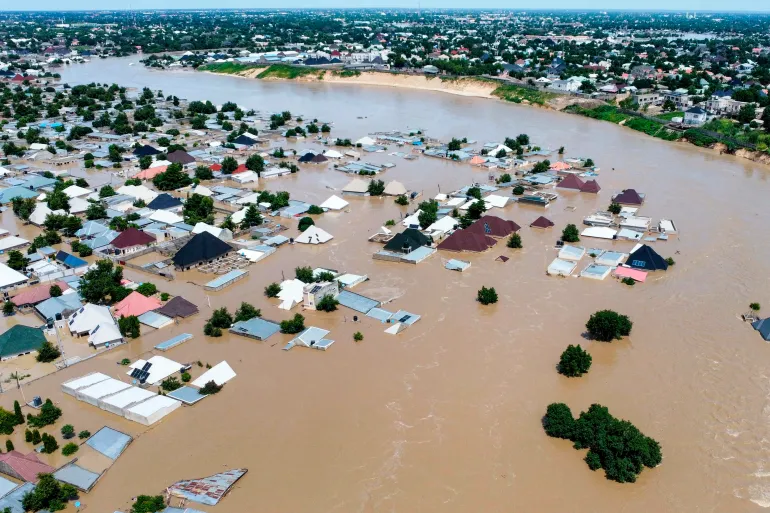In Adamawa, three dead, while 40 people suffered injuries during a fatal flood incident after a heavy downpour soaked some part of the state on Thursday, 18th September, 2025.
This was disclosed by the National Emergency Management Agency (NEMA), noting that nothing less than 1,415 households in Yola North and Yola South Local Government Area of the State, were caught in the unprecedented crisis.
The casualties were confirmed after what was termed as “rapid assessment” conducted in collaboration with the Adamawa State Emergency Management Agency (ASEMA).
Several farmlands, including critical infrastructures were flooded by the incident, affecting 13 communities in the two Local Government Areas.
The emergency bodies also added that the families who suffered displacement by the incident have been relocated to flood resentment camps in Girei, while others were being sheltered within the host communities.
Effects of Recurring Flood in Nigeria
The flood incident has become a major humanitarian crisis across Nigeria. Over 1.8 million individuals have been impacted by relentless rains, leading to widespread displacement, loss of lives and destruction of homes and livelihoods. Houses, farmlands and critical infrastructure have been devastated, with 98,242 homes being affected.
In 2024, over five million people were affected due to flooding in Nigeria. This was disclosed by the Director General of the National Emergency Management Agency (NEMA), Mrs. Zubaida Umar, stating that the 2024 incident resulted in the loss of 1,237 lives and widespread destruction across 35 states of the country.
The report further added that the 2024 floods led to the displacement of over 1.2 million persons, with the destruction of 115,172 houses and 1.4 million hectares of farmland across 401 Local Government Areas.
Therefore, NEMA has recently identified 12 states, and 43 local governments in Nigeria being prone to high risk of flooding amidst the 2025 rainy season. Another 13 states fall within the low- risk category.
Poor drainage system was identified among the major reasons that caused the devastating flood disaster while suggesting improvement of drainage system in those areas.
Adamawa Earlier Crisis
In a collaborative effort, a Joint Rapid Assessment (JRA) in response to the flash flood incident was conducted in August to know the impact of the crisis in Adamawa State. Among the assessed communities are Bako, Bole Yolde Pate, Makama A and Makama B of Yola South Local Government Area.
The assessment was facilitated to dive into the extent of the impacts of the flood on the affected population and infrastructure, in order to further inform the governments and humanitarian actors on the necessary urgent needs, vulnerabilities, and displacement dynamics.
The taskforce identified approximately 15,128 individuals which is equivalent to 3,057 households who were crippled by the flood. Another 4,890 people (or 720 households) were also displaced within the host community, with others who remained in their community being significantly impacted.
Damage to habitations resulting from the incident was damning. 16–percent of the houses affected were completely destroyed, with 38–percent partially damaged, while 46–percent underwent repairs before they became habitable.
Livelihoods were not also spared. More than 158 farmlands were submerged, posing a significant state of emergency on food security, and revenue generation.
2025: Soaring Figures
Despite fatal casualties being witnessed in the preceding years, the growing flood crisis in the ongoing year has exposed a gap in the country’s risk management to tackle the problem.
To wit; recall that the 2025 flood incident that unfolded in Mokwa, Niger state, claimed nothing less than 100 lives, while displacing 1,005 people, leaving counts of people injured, as others went missing.
In August, five people were recorded to be dead, as other three people went missing after a devastating flood stormed Enohia Itim community in Afikpo Local Government Area of Ebonyi State. Over 800 farmers were reported to have seen their farmlands being destroyed by the flood.
Similarly, a viral video captured how residents of Ikorodu community of Lagos State, cried out when their houses, properties and livelihoods were submerged after persistent heavy rainfall gripped the area for more than one week.
Therefore, poor drainage systems were identified among the major reasons that caused the devastating flood disaster while suggesting improvement of drainage systems in those affected areas.
In addition to the frequency and severity of floods in Nigeria, experts believed that lack of political will to implement longstanding solutions has drastically contributed to the problem, as unregulated construction and poor drainage infrastructure mar the country.

